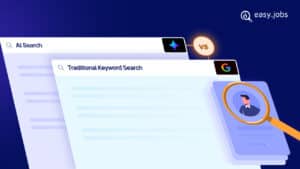In the fast-paced world of talent acquisition, where competition for top-notch candidates is akin to a thrilling quest for hidden treasure, every hiring manager yearns for a map that leads straight to the brightest gems. To stay ahead of the competitive hiring game, you need to explore and be aware of the top recruiting metrics, a complete pack of KPIs that can help HR professionals navigate through the dense jungle of recruitment challenges, pointing them toward the elusive key to hiring success.

So, are you ready to transform your hiring process and revolutionize the way you find the finest talent? Let’s embark on this epic adventure together, unlocking the secrets of recruiting metrics and unveiling the hidden gems that await you in the ever-evolving landscape of talent acquisition!
Understanding The Basics: What Are Recruiting Metrics?
Recruiting metrics, also known as recruitment metrics or talent acquisition metrics, are quantitative measurements used to assess and evaluate various aspects of the recruiting process. These metrics help recruiters and HR professionals understand the effectiveness and efficiency of their recruitment efforts, identify areas for improvement, and make data-driven decisions to optimize the hiring process.
The metrics vary depending on the organization’s goals and priorities, but standard recruiting metrics should be included in every organization. By tracking and analyzing these recruiting metrics, companies can gain insights into their recruitment performance and make data-driven decisions to improve the overall effectiveness of their hiring process.
Why Should You Track Recruiting Metrics?
Tracking recruiting metrics is essential for several reasons, as it provides numerous benefits to organizations and their talent acquisition efforts. Here are some key reasons why you should track recruiting metrics:
1. Data-Driven Decision Making
Recruiting metrics provide objective data and insights into the recruitment process. This data allows recruiters and HR professionals to make informed decisions based on actual performance rather than relying on intuition or assumptions.
2. Identify Areas For Improvement
You can identify bottlenecks, inefficiencies, or weaknesses in the recruitment process by tracking metrics. This helps you pinpoint areas that need improvement and allows you to take corrective actions to enhance the overall recruitment strategy.
3. Measure Recruitment Effectiveness
Recruiting metrics help gauge the success of your recruitment efforts. Metrics like time-to-fill, offer acceptance rate, and quality of hire provide a clear picture of how well your organization is attracting, converting, and retaining top talent.
4. Optimize Recruitment Budget
Tracking metrics like cost-per-hire and sourcing channel effectiveness helps organizations allocate their recruitment budget more effectively. It allows them to invest in the most fruitful channels and optimize spending to get the best return on investment.
5. Enhance Diversity And Inclusion
By monitoring diversity metrics in the recruitment process, organizations can identify if they are attracting a diverse pool of candidates. It helps to ensure that their hiring practices are inclusive.
6. Measure Employer Branding
Recruiting metrics can indirectly reflect the strength of an organization’s employer brand. Positive metrics, such as high applicant conversion rates, may indicate a strong employer brand that attracts qualified candidates.

Tracking recruiting metrics is crucial for optimizing the recruitment process, improving candidate experiences, and aligning talent acquisition strategies with business goals. It empowers organizations to make data-driven decisions that can lead to better hiring outcomes and a more competitive edge in attracting and retaining top talent.
Here Are 10 Important Recruiting Metrics To Check Out
As we uncover the hidden power of recruiting metrics, we will revolutionize hiring practices, tame the wild unknowns, and illuminate the path to building stellar teams. From traditional stalwarts like Time-to-Fill and Cost-per-Hire to cutting-edge measurements like the Candidate Experience Index and Quality of Hire, we shall explore the arsenal of data-driven insights that empower recruiters to make informed choices and outshine their competition.
Here are the top 10 essential recruiting metrics you need to track:
1. Time To Fill (TTF)
Time to fill measures the number of days it takes to fill a job opening from the time the job opening post or circular is approved to the time the offer is accepted by the candidate. This measure is frequently influenced by supply and demand, and a number of other factors, such as industry needs or the speed at which a hiring team works, can contribute to this. Time to fill is an essential indicator since it gives recruiters and hiring managers a clearer idea of how long it typically takes to fill open positions. A shorter TTF indicates an efficient hiring process, which is essential for reducing the cost and effort associated with vacancies.
2. Time To Hire (TTH)
Time to hire measures the number of days from the initial application submission to the candidate’s acceptance of the job offer. It gives insights into the speed of the selection process and helps identify bottlenecks.
The length of time it takes to hire someone might vary greatly depending on the position and how your firm approaches recruiting. A very simple hiring procedure can speed up the hiring process, while positions requiring numerous rounds of interviews, panel discussions, test projects, and other stages will take much longer to fill.
3. Sourcing Channel Effectiveness
This metric assesses the performance of various sourcing channels, such as job boards, social media, employee referrals, and career fairs, in attracting qualified candidates. Understanding the best-performing channels helps allocate resources more effectively.
One can compare the channels that produce applicants and hires to those that do not by analyzing sourcing channel efficacy. This information aids in your decision to spend less time and money on channels that don’t produce well.
4. Candidate Experience
Candidate Experience metrics focus on the satisfaction level of candidates throughout the hiring process. Feedback surveys, candidate Net Promoter Score (NPS), and other qualitative data provide insights into how candidates perceive the company’s recruitment process.
75% of job seekers consider an employer’s brand before even applying for a job.
5. Offer Acceptance Rate
The percentage of job offers that candidates who have been extended an offer to work for a company accept is known as the offer acceptance rate. HR professionals use this statistic to see where improvements may be made and to assess how effective their recruitment and selection process is. A low acceptance rate may indicate job offers, compensation, or candidate fit issues. So you can include this in your recruiting metrics as well.
6. Cost Per Hire (CPH)
Cost per hire calculates the average cost incurred to fill a single position. This includes advertising expenses, recruitment agency fees, onboarding costs, and other related expenditures. Keeping CPH under control is crucial for optimizing recruitment budgets.
Their cost-per-hire formula is quite simple:

Here,
Internal recruiting costs = Internal personnel, organizational, and capital expenses related to hiring
External recruiting costs = Expenditure incurred during the hiring process for outside vendors or people.
7. Quality Of Hire (QoH)
Quality of Hire evaluates the performance and long-term success of new hires. It can be measured through employee performance reviews, productivity levels, and retention rates. A high QoH indicates the effectiveness of the hiring process in selecting top talent.
Here is the equation to calculate QoH.

Here,
Indicators can be new hire performance, new hire engagement, culture fit, etc.
8. Applicant-To-Interview Ratio
This ratio tracks the number of applicants who progress to the interview stage. During the hiring process, recruiters use this measure to help them narrow down the best prospects. A low ratio might indicate issues with the screening process or a need for more qualified candidates.
The location, industry, job market, and position level can all affect the optimal offer acceptance rate. In the recruiting industry, according to SHRM’s Talent Acquisition Benchmarking Report is: A high offer acceptance rate is typically defined as 90% or greater.
9. Offer-To-Acceptance Ratio
Offer-To-Acceptance Ratio measures the number of job offers extended to candidates compared to the number of offers accepted. A low ratio may suggest the need to reevaluate the job offers or improve the candidate experience.
There is some leeway in this statistic. Although it’s often computed once a year, you can compute it more often if, for instance, you’ve had a busy month of hiring. You may also figure out the acceptance percentage of jobs for each department, hiring manager, and recruiter.
10. Turnover Rate
While not exclusively a recruiting metric, Turnover Rate helps measure the effectiveness of talent retention efforts. A high turnover rate can indicate issues with the hiring process or the work environment. Here is the equation to measure the turnover rate:

In a similar way, you can count the annual turnover rate of your organization. The distinction is that hires dilute the first formula. For this reason, in order to provide a more pure number, we suggest dividing ‘Hires’ and ‘Employees’ into two separate groups. As previously indicated, Hires have a unique set of KPIs, such as first-year and 90-day turnover.
Tracking key recruiting metrics is crucial for businesses to measure the effectiveness and efficiency of their hiring processes. These metrics help HR teams and recruiters make data-driven decisions to improve their recruitment strategies and ultimately attract and hire the best talent.
Scale Up Your Hiring Process Right Away With The Top Metrics 🚀

By regularly tracking these recruiting metrics, organizations can gain valuable insights into their recruitment strategies and make data-driven improvements to attract and retain top talent more effectively. It’s important to note that these metrics may vary in significance depending on the specific goals and needs of each organization. Have you found this blog helpful? Then don’t forget to share with others. Also, subscribe to our blog for further recruiting tips and tricks.





